
Drinking whiskey is a magical experience. It’s a drink you can savor with close friends, or enjoy while making new friends at your local bar or pub. And there are quite a number of ways to enjoy whiskey: You can drink it neat, shake or stir it into a modern cocktail, or concoct rejuvenating glasses of classic whiskey cocktails.
On top of that, there’s a whiskey for everyone, from stellar American single malt and bourbon options made right here in the States to age-old peaty expressions out of Scotland and up-and-coming whiskies from promising distillers in Australia.
You don’t need to spend a lot of cash to get started on whiskey. Feel free to check out our list of the best cheap whiskey under $20 and rye whiskey brands under $50 if you’re interested in cost-effective options.
But if you would like to add whiskey to your growing list of hobbies, we worked with Tommy Tardie, world-renowned whiskey connoisseur and the owner of The Flatiron Room and Fine & Rare, to help you understand the peculiarities of this fascinating hobby.
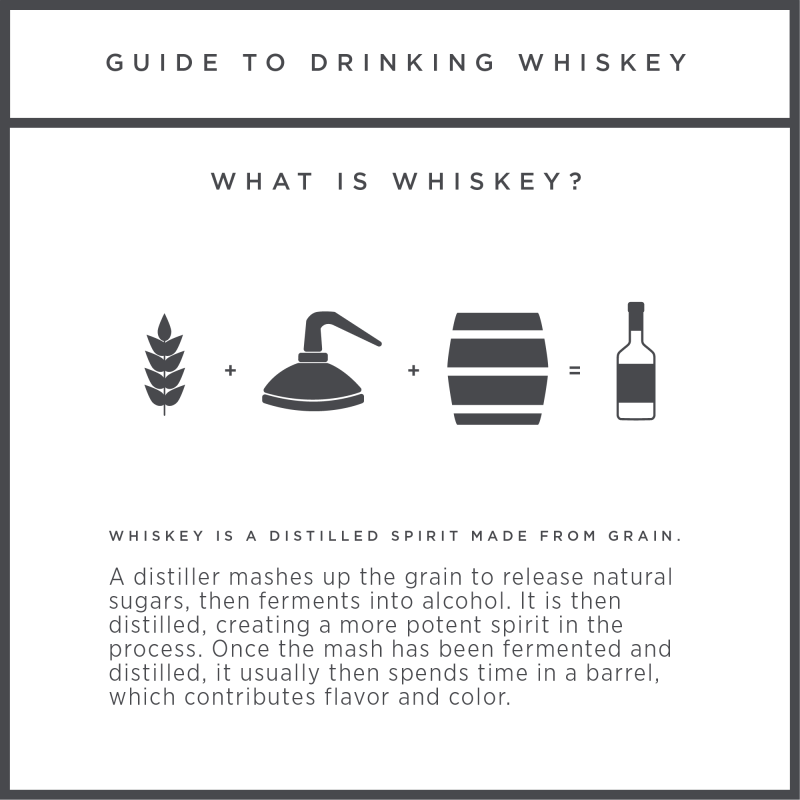
What is whiskey?
If you’re a frequent visitor to The Manual, then you probably don’t need an introduction to whiskey. In fact, there’s a decent chance you’re nursing a tumbler at this very moment. Still, learning more about the wide world of whiskey can help boost your enjoyment. Tardie embarked on an international mission to learn everything he could about whiskey before opening The Flatiron Room. Before we get to Tardie, though, let’s break down what whiskey actually is (for those who don’t know or aren’t sure of all the specifics).
In short, whiskey is a distilled spirit made from grain.
In short, whiskey is a distilled spirit made from grain. To get to the distillation point, a distiller mashes up the grain to release natural sugars, which he or she then ferments into alcohol. That alcohol is then distilled, creating a more potent spirit in the process. The grain that’s used can vary, but more often than not you’ll find whiskies made with corn, rye, wheat, and barley (both malted and not). Other grains such as millet and quinoa are used on occasion, but the four we just mentioned are the major players. Once the mash has been fermented and distilled, it usually then spends time in a barrel, which contributes flavor and color.
And voila! Whiskey in a nutshell. Now, onto the man who has taken the New York City whiskey world by storm, Tommy Tardie.
“The great things about whiskey are that it is so diverse and can appeal to a very broad range of palates,” Tardie says. “Bourbon, rye, single malts, blends — they’re all whiskey.” (If you’re curious about the different spellings of “whiskey,” here’s a quick breakdown of the difference.)
If there’s a theme to this guide, it’s “exploration.” There’s no one right way to drink all whiskeys — instead, enjoying this beverage is a personal journey that could easily change from week to week, day to day, drink to drink. The protocol outlined in this guide works well with any whiskey under the golden sun. We’ll take you through the basics, but ultimately you have to follow your own palate.

How to drink whiskey
Enjoying whiskey straight or neat
The next time you have a glass of whiskey, resist the urge to immediately toss ice into it. You’ll find that many whiskeys are greatly enhanced by ice, but you’d be doing yourself a disservice if you don’t at least try the whiskey neat.
“Before I got into the hospitality game, I would usually order a whiskey neat when I went out,” says Tardie, recommending neat whiskey for those who enjoy the taste of alcohol. “I would refer to my whiskey as a single-ingredient cocktail.”
If you find that you don’t like your whiskey neat, that’s totally fine. With the high alcohol content (approximately 40% to 43% alcohol by volume) and bold flavor profiles, a glass of straight whiskey can be like a slap in the face to your taste buds. In order to get more of a warm hug experience, why not try adding a little water?

Why you can add water to whiskey
If you’re new to the world of whiskey, you might roll your eyes at the prospect of adding a few drops of water. How could a drop of water make a difference?
“A splash of water can be a great thing,” says Tardie. “A little water releases the hydrophobic (water repellent) elements in the glass, allowing you to detect more aromatics on the nose and, by lowering the alcohol content, it can allow you to taste more flavors on your palate.”
The easiest way to go about this is with a glass of water and a straw. Simply add a drop, give your whiskey a swirl, take a sip, and repeat until you find the pleasing flavors you’re looking for. The bigger the splash, the more diluted your whiskey will become, achieving the effect of ice without chilling the refreshment.
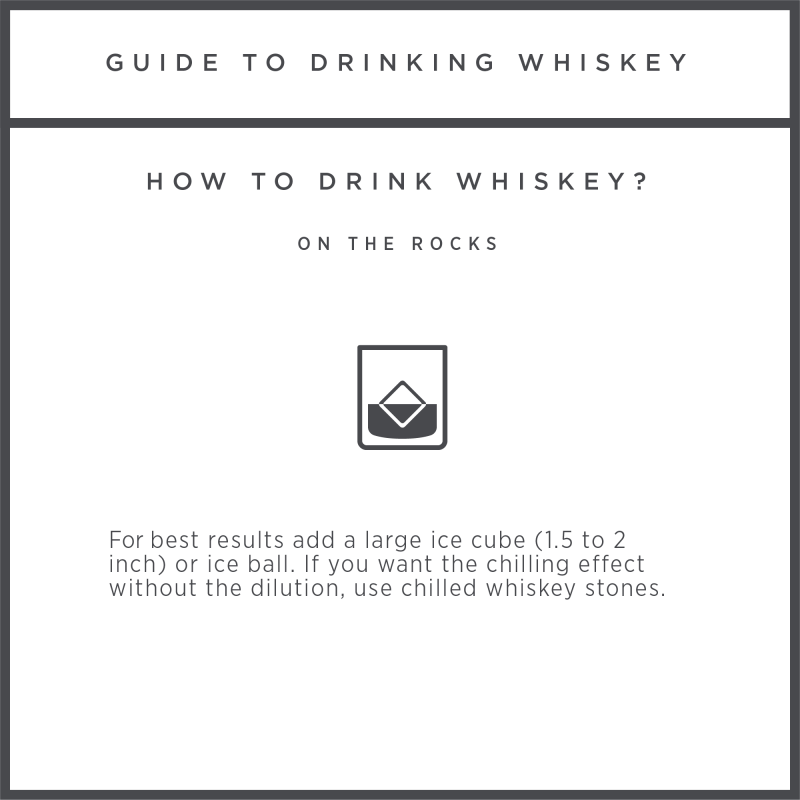
Should you get whiskey on the rocks?
Ordering a whiskey “on the rocks” may sound cool, but it may not necessarily be what you want. “Ice actually numbs your palate and dulls the flavors,” Tardie laments. “But hey, sometimes you just want a cold glass of whiskey — I say go for it.”
As for the type of ice, you’re best off going with a large ice cube (1.5 to 2 inches) or ice ball. Small cubes or chunks of ice will melt faster than larger pieces, diluting your whiskey more quickly. If you want the chilling effect without the dilution, you might consider adding chilled whiskey stones.
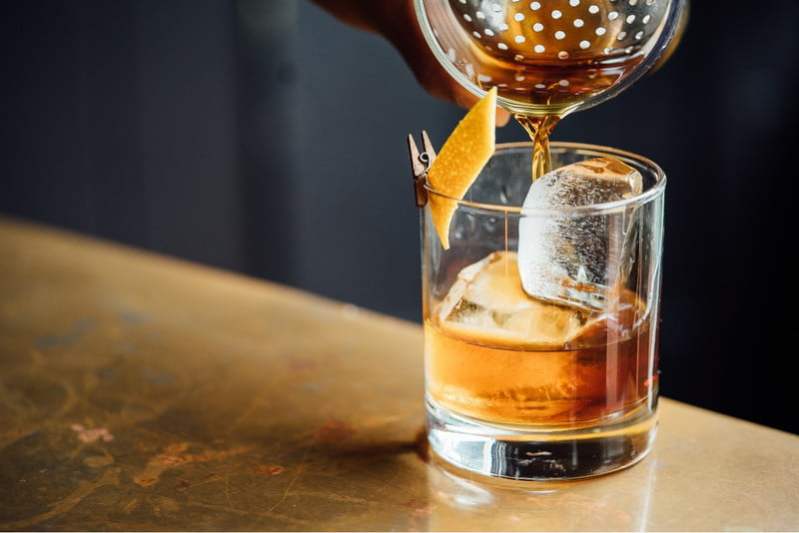
Whiskey cocktails
If you simply don’t like the taste of whiskey by itself, or if you’re looking for a new way to enjoy whiskey, we urge you to try it in a classic cocktail. Tardie recommends rye whiskey bases due to their assertiveness and ability to hold their own in a mix.
Had your fill of the classics? Try out simple twists on time-tested recipes, especially ones where you wouldn’t expect whiskey. “Because the profile of whiskey is so diverse, you can have a lot of fun experimenting with the various flavors,” says Tardie, whose only experimental kryptonite is frozen water. “[At Fine & Rare, Tardie’s restaurant venture] we offer a unique twist on the Bloody Mary but we substitute vodka with Ardbeg, a heavily seated single malt from Islay.”
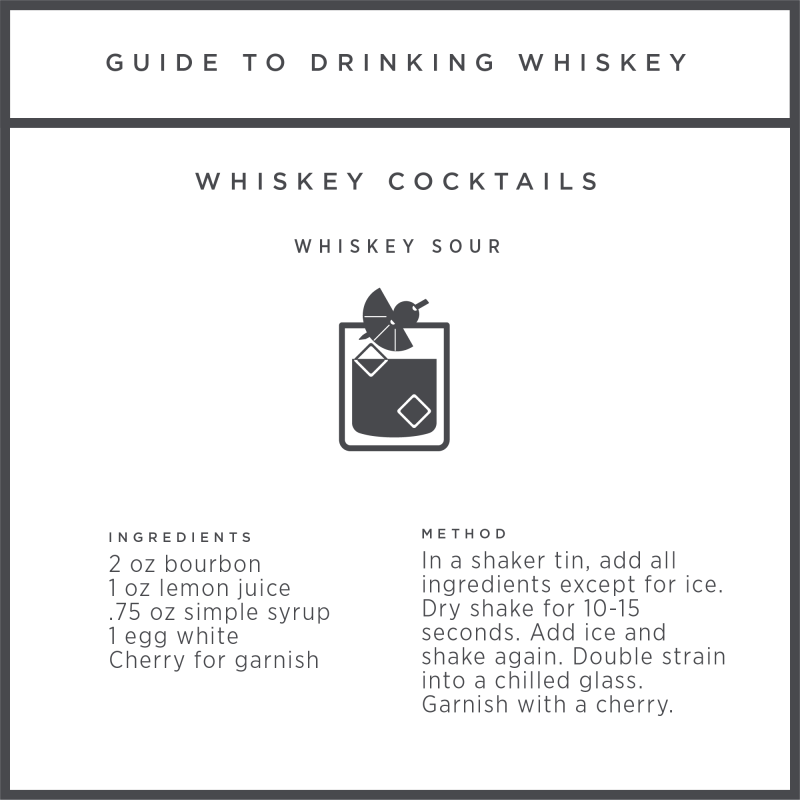
Whiskey sour
Ingredients
- 2 ounces bourbon
- 1 ounce lemon juice
- 3/4 ounce simple syrup
- 1 egg white
- Cherry for garnish
Method
- In a shaker tin, add all ingredients except for ice.
- Dry shake for 10-15 seconds. Add ice and shake again.
- Double strain into a chilled glass and garnish with a cherry.
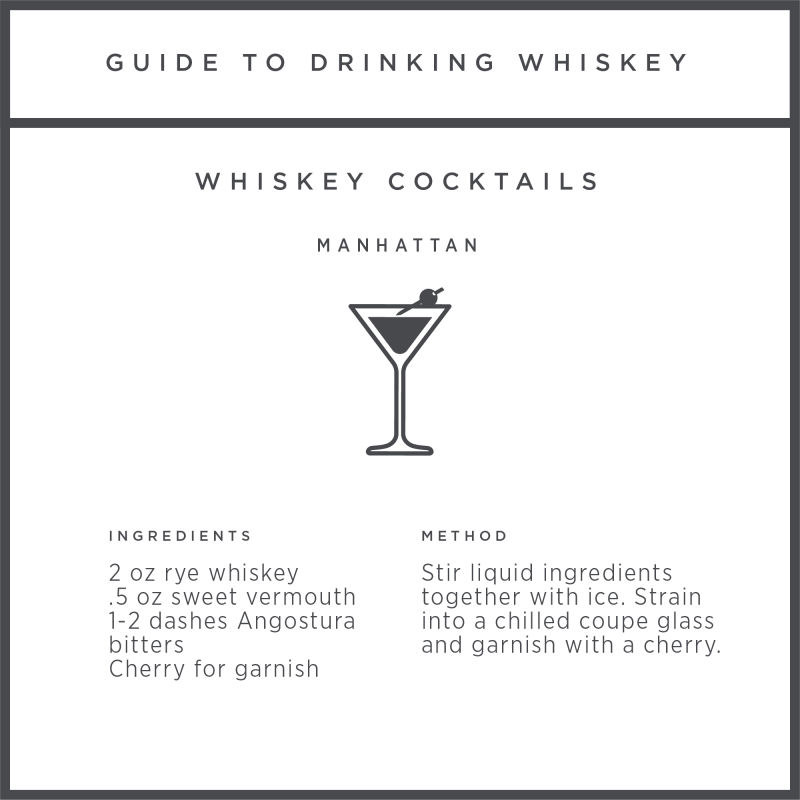
Manhattan
Ingredients
- 2 ounces rye whiskey
- 1/2 ounce sweet vermouth
- 1-2 dashes Angostura bitters
- Cherry for garnish
Method
- Stir liquid ingredients together with ice.
- Strain into a chilled coupe glass and garnish with a cherry.
Glassware
Similar to wine or beer, there’s special glassware designed specifically for drinking whiskey. If you’re enjoying it neat, try to use a tulip-shaped glass or a small snifter of some kind. The shape allows you to better appreciate the fragrance of the spirit. When making up whiskey cocktails, it pays to have a few standard glass shapes in your bar drawer. We suggest an Old Fashioned glass, a martini glass, and a coupe glass. And get at least two of each, as you’ll likely be imbibing with a friend.
Ultimately, you’ll find what works for you, so take these parting wise words about whiskey from Tardie to heart: “Experiment and find what’s right for you. Don’t let anyone tell you how to enjoy it.”
(Except for us.)
Looking for more great stuff? If you want to explore the mesmerizing world of liquor, we also published a beginner’s guide to sherry wine, including a list of the best spirits.
Editors' Recommendations
- The science of drinking at high altitudes (plus, expert tips for your mid-flight cocktail)
- Is honey a superfood? Here are 10 reasons we think so
- Level up your backyard barbecue with these easy tips from an expert pitmaster
- How to use Pimm’s for a refreshing cocktail this summer
- These 4th of July vodka drink recipes from Tina’s Vodka are just plain great





